Complete Solutions to PRACTICE QUESTIONS (Single Correct Choice Type) of chapter INTERFERENCE AND DIFFRACTION of Class 12 book with complete answers and questions
| Class 12 | PHYSICS |
| Chapter | INTERFERENCE AND DIFFRACTION |
| RESNICK AND HALLIDAY | PRACTICE QUESTIONS (Single Correct Choice Type) |
| Number Of Questions | 66 |
| Academic Year | 2023-24 |
The intensity ratio of the two interfering beams of light is m. What is the value of `I_("max")-I_("min") // I_("max")+I_("min")`?
View SolutionA parallel beam of light of intensity I is incident on a glass plate. `25%` of light is reflected in any reflection by upper surface and `50%` of light is reflected by any reflection from lower surface. Rest is refracted The ratio of maximum to minimum intensity in interference region of reflected rays is
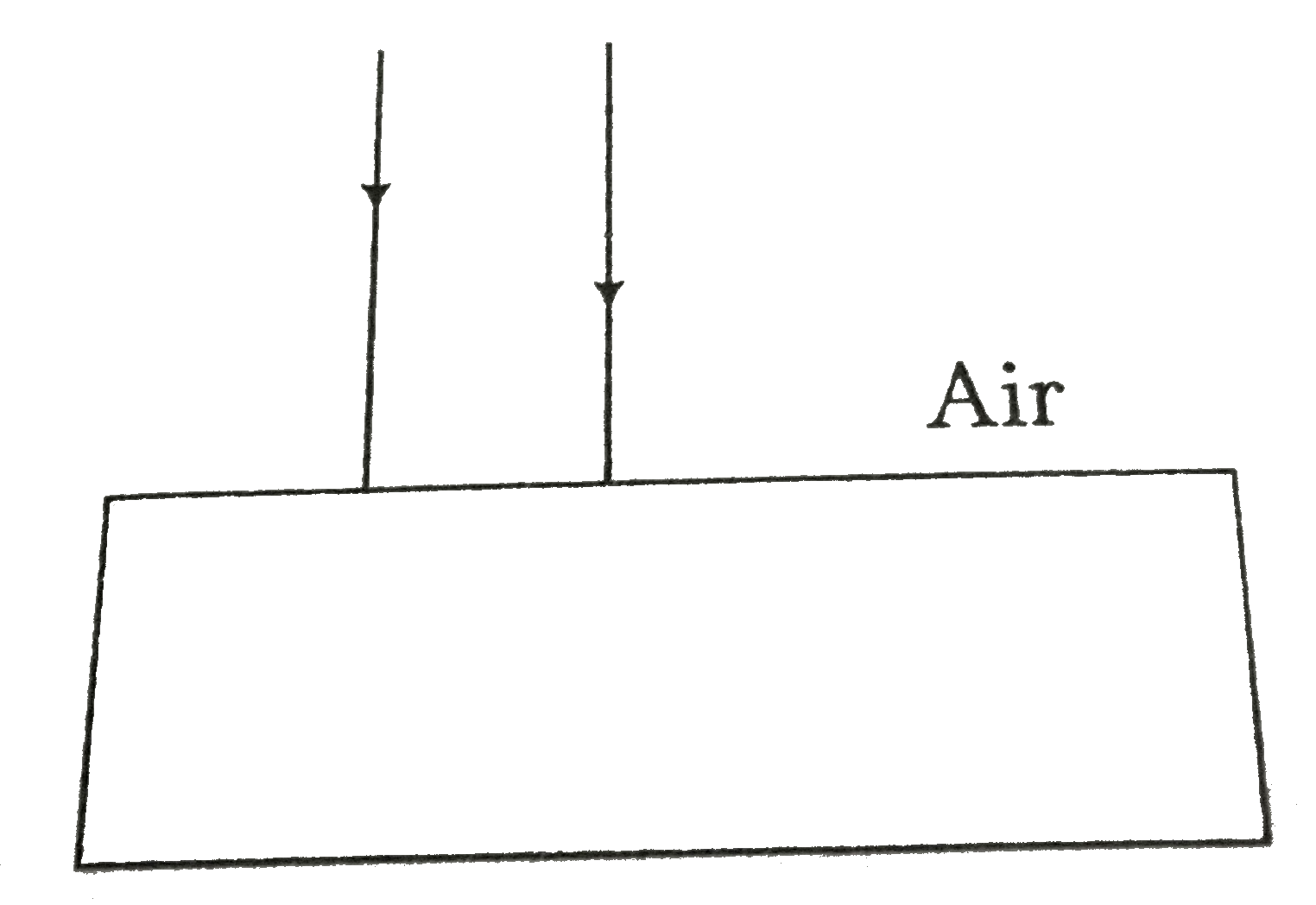
View SolutionWhat happens to the interference pattern if the two slits in Young's experiment are illuminated by two independent sources such as two sodium lamps S and S' as shown in figure

View SolutionIn Young's experiment, monochromatic light is used to illuminate the two slits A and B. Interference fringes are observed on a screen placed in front of the slits. Now, if a thin glass plate is placed normally in the path of the beam coming from the slit, then
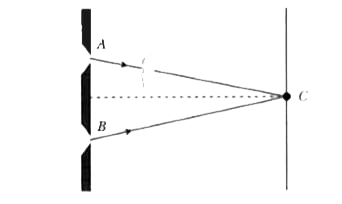
View SolutionIn Young's double slit experiment, the intensity at a point where the path difference is `lamda/6` (`lamda` is the wavelength of light) is I. if `I_(0)` denotes the maximum intensities, then `I//I_(0)` is equal to
View SolutionThe angle of polarisation for any medium is `60^(@)` , what will be critical angle for this
View SolutionWhite light is used to illuminate the two slits in Young's experiment. The separation between the slits is d and the screen is at a distance D(»d) from the slits. At a point directly in front of one of the slits, certain wavelength is missing. The missing wavelength
View SolutionLight passes successively through two polarimeters tubes each of length `0.29m`. The first tube contains dextro rotatory solution of concentration `60kgm^-3` and specific rotation `0.01 rad m^2kg^-1`. The second tube contains laevo rotatory solution of concentration `30kg//m^3` and specific rotation `0.02 rad m^2kg^-1`. The net rotation produced is
View SolutionTwo Nicols are oriented with their principal planes making an angle of `60^@`. The percentage of incident unpolarised light which passes through the system is
View SolutionIn the visible region of the spectrum the rotation of the place of polarization is given by `theta=a+(b)/(lambda^2)`. The optical rotation produced by a particular material is found to be `30^@` per mm at `lambda=5000Å` and `50^@` per mm at `lambda=4000Å`. The value of constant a will be
View SolutionWhen a ray of light of frequency `6 xx 10^(14)` Hz travels from water of refractive index `4 // 3` to glass of refractive index `8 // 5`, its
View SolutionA wavefront AB passing through a system C emerges as DE (As shown in the following figure). The system C could be
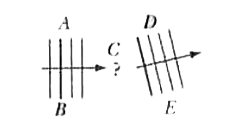
View SolutionThe wavefront of a light beam is given by the equation `x + 2y + 3x = c` (where c is arbitrary constant), then the angle made by the direction of light with the y-axis is
View SolutionIn Young's double-slit interference experiment a first screen with a single narrow slit is used in addition to the double-slit screen. An interference pattern is observed on the screen. What happens if the first screen is removed and light from an extended but monochromatic source, e.g.,yellow light from large sodium vapor lamp, is allowed to illuminate the double-slit screen directly?
View SolutionTwo sources, in phase and a distance d apart, each emit a wave of wavelength l (as shown in the following figure). Which of the choices for the path difference `Delta L = Delta P = S_(2)P - S_(1)P Delta L = L_(1)-L_(2)` will always produce constructive interference at point P?
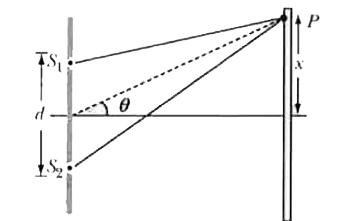
View SolutionIn a double-slit interference pattern, the first maxima for infrared light would be
View SolutionLight shining through two very narrow slits produces an interference maximum at point P when the entire apparatus is in air as shown in the following figure. For the interference maximum represented, light through the bottom slit travels one wavelength further than light through the top slit before reaching point P. If the entire apparatus is immersed in water, the angle `theta` to the interference maximum
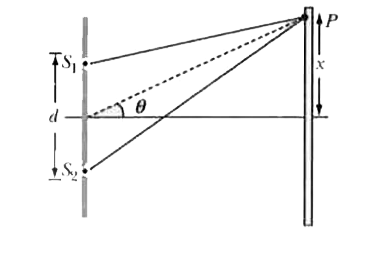
View SolutionIn Young's double-slit experiment, the slit separation is 0.5 mm and the screen is 0.5 m away from the slit. For a monochromatic light of wavelength 500 nm, the distance of 3rd maxima from the 2nd minima on the other side of central maxima is
View SolutionTwo different color beams (yellow and blue) from a point source are incident on both slits of a Young's double-slit experiment setup
View SolutionTwo wavelength of light `lambda_(1)` and `lambda_(2)` are sent through Young's double-slit apparatus simultaneously. What must be true about `lambda_(1)` and `lambda_(2)` if the third-order bright fringe of `lambda_(1)` coincides with fifth-order dark fringe of `lambda_(2)`
View SolutionIn a Young's double-slit experiment, if the incident light consists of two wavelengths `lambda_(1)` and `lambda_(2)`, the slit separation is d, and the distance between the slit and the screen is D, the maxima due to each wavelength will coincide at a distance from the central maxima, given by
View SolutionTwo plane monochromatic coherent waves produce inter- ference pattern (of alternately bright and dark bands) on a screen. When the angle between the two beams is decreased the fringe width
View SolutionPath followed by two rays through a thin lens in air is shown in the following figure. (Assume value of `mu` of lens same for both rays.) Optical path followed for two rays from A to B is
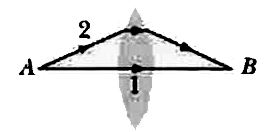
View SolutionAn interference pattern is formed on a screen by shining a planar wave on a double-slit arrangement. If we cover one slit with a glass plate, the phases of the two emerging waves will be different because the wavelength is shorter in glass than in air. If the phase difference is `180^(@)`, how is the interference pattern altered?
View SolutionA glass slab of thickness `4 cm` contains the same number of waves as `5 cm` of water, when both are traversed by the same monochromatic light. If the refractive index of water is `4//3,` then refractive index of glass is
View SolutionOn introducing a thin sheet of mica (thickness `12 xx 10^(-7)` cm) in path of one of the interfering beams (`lambda_("vacuum") = 600 nm`) in Young's double-slit experiment, the central fringe is shifted through a distance equal to the spacing between successive bright fringes. Calculate the refractive index of mica.
View SolutionA Young's double-slit experiment is conducted in water `(n_(1))` as shown in the following figure, and a glass plate of thickness t and refractive index `n_(2)` is placed in the path of `S_(2)`. Wavelength of light in water is `lambda`. Find the magnitude of the phase difference between waves coming from `S_(1)` and `S_(2)` at O.
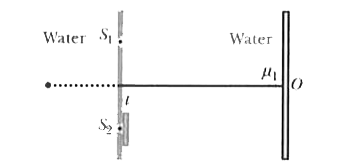
View SolutionIn a Young's double-slit experiment, green light is incident on the two slits. The interference pattern is observed on a screen. Which one of the following changes would cause the observed fringes to be more closely spaced?
View SolutionWhy isn't the interference pattern like the one from Young's double-slit experiment produced from the two headlights of a car?
View SolutionCoherent light is incident on two fine parallel slits `S_(1)` and `S_(2)` as show in fig. If a dark fringe occurs at P, which of the following gives possible phase difference for the light waves arriving at P from `S_(1)` and `S_(2)` ?

View SolutionThree coherent, equal intensity light rays arrive at a point Pon a screen to produce an interference minimum of zero intensity. If any two of the rays are blocked, the intensity of the light at P is `I_(1)`. What is the intensity of the light at P if only one of the rays is blocked?
View SolutionIn a Young's double slit experiment, if the slits are of unequal width
View SolutionIntensities of light due to the two slits of Young's double-slit experiment are I and 4I. How far from the centre maxima will the intensity be equal to the average intensity on the screen? (`beta` is the fringe width.)
View SolutionIn a Young's double-slit interference pattern, the intensity of the central fringe at `P =I_(0)`. When one slit width is reduced to half, the intensity at P will be
View SolutionIn a Young's double-slit experiment, the central bright fringe can be identified
View Solution_E01_026_Q01.png)
As shown in the right figure, a point light source is placed at distance 2f from a lens with focus length f. and a screen is placed at 4f from the lens. The lens is then cut at the middle into two equal portions: upper half and lower half. the upper half is moved upwards by a small distance d comparable to the light wavelength and the lower half is moved downwards by the same distance d. What is the light pattern on the screen?
View SolutionA fresnel biprism is used to form the inerference fringes. The distance between the source and the biprisim is 20 cm and that between the biprism and the screen is 80 cm. If A= 6563 A and the separation between the virtual sources is 3.6 mm, then the fringes width (in mm) is.
View SolutionIn a biprism experiment, the biprism is made of glass (n = 1.5). When the setup is shifted from air to the inside of a still, clear lake water `(n = 4 // 3)` then
View SolutionTwo radio station that are 250 m apart emit radio waveslength 100m. Point A is 400m from both station.Point B is 450m from both station. Point C is 400m from one station and 450 m from the other.The radio station emit radio waves in phase. Which of the following statement is true ?
View SolutionA soap film of thickness is surrounded by air. It is illuminated at near normal incidence by monochromatic light which has wavelength `lambda` in the film. What will be the film thickness that will produce maximum brightness of the reflected light?
View SolutionA thin oil film of refracting index `1.2` floats on the surface of water `(mu=4/3)`. When a light of wavelength `lamda=9.6xx10^(-7)m` falls normally on the film air, then it appears dark when seen normally. The minimum change in its thickness for which it will appear bright in normally reflected light by the same light is `Zxx10^(-7)m`. Then find `Z`.
View SolutionWhite light is normally incident on a soap bubble in air, and the reflected light is viewed. As the wall thickness of the bubble approaches zero (just before it breaks) the reflected light
View SolutionLight is reflecting off a wedge-shaped thin piece of glass producing bright and dark interference fringes. If a certain location has a bright fringe, a nearby point will have a dark fringe if the thickness of the glass increases by
View SolutionConsider two identical inicroscope slides in air illumi- nated with monochromatic light. The bottom slide is rotated (counterclockwise about the point of contact in the side view) so that the wedge angle gets a bit smaller. What happens to the fringes?
View SolutionRadio waves are readily diffracted around buildings whereas light waves are negligibly diffracted around buildings. This is because radio waves
View SolutionThe shimmering or wavy lines that can often be seen near the ground on a hot day are due to
View SolutionIf the Huygen's principle applies to any point anywhere in a beam path, why does not a laser beam without any slit spread out in all directions?
View SolutionNo fringes are seen in a single-slit diffraction pattern if
View SolutionMonochromatic plane waves of light are incident normally on a single slit. Which option correctly shows the diffraction pattern observed on a distant screen?
View SolutionA single slit with the direction to a point P on a distant screen as shown in the following figure. At P, the pattern has its second minimum (from its central maximum). If X and Y are the edge of the slit, what is the path length difference (PX) - (PY)?

View SolutionAt the first minimum adjacent to the central maximum of a single-slit diffraction pattern the phase difference between the Huygens wavelet from the edge of the slit and the wavelet from the mid-point of the slit is
View SolutionA diffraction-limited laser of length l and aperture diameter d generates light of wavelength `lambda`. If the beam is directed at the surface of the Moon a distance D away, the radius of the illuminated area on the Moon is approximately
View SolutionTwo stars that are close together are photographed through a telescope. The black and white film is equally sensitive to all colors. Which situation would result in the most clearly separated images of the stars?
View SolutionResolving power of a telescope can be increased by
View SolutionIn a double-slit diffraction experiment, the number of interference fringes within the central diffraction maximum can be increased by
View SolutionA double slit is illuminated with monochromatic light of wavelength `6.00 xx 10^(2)` nm. The m = 0 and m = 1 bright fringes are separated by 3.0cm on a screen which is located 4.0 m from the slits. What is the separation between the slits?
View SolutionTwo slits are separated by `2.00 xx 10^(-5)` m. They are illuminated by light of wavelength `5.60 xx 10^(-7)` m. If the distance from the slits to the screen is 6.00 m, what is the separation between the central bright fringe and the third dark fringe?
View SolutionA `4.0 xx 10^(2)` nm thick film of kerosene (n = 1.2) is floating on water. White light is normally incident on the film. What is the visible wavelength in air that has a maximum intensity after the light is reflected?
Note: The visible wavelength range is 380 nm to 750 nm.
View SolutionA portion of a soap bubble appears green ( `lambda = 500.0 nm` in vacuum) when viewed at normal incidence in white light, Determine the two smallest, non-zero thicknesses for the soap film if its index of refraction is 1.40.
View SolutionLight of wavelength `lambda` in vacuum strikes a lens that is made of glass with index of refraction 1.6. The lens has been coated with a film of thickness t and index of refraction 1.3. For which one of the following conditions will there be no reflection?
View Solution_E01_041_Q01.png)
Light wavelength 650 nm is incident normally upon a glass plate the glass plate rests on top of second plate so that hey touch at one end and are separated by 0.0325 mm at the other end as shown in the figure. Which range of values contains the horizontal separation between adjacent bright fringes?
View SolutionTwo glass plates, each with an index of refraction of 1.55, are separated by a small distance D. The space between the plates is filled with water (n = 1.33) as shown. For which one of the following conditions will the reflected light appear green?
Note: The wavelength of green light is 460 nm in vacuum.
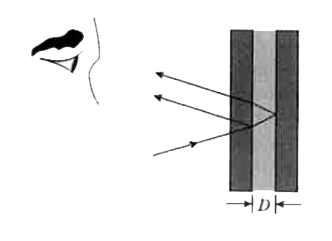
View SolutionLight of 600.0 nm is incident upon a single slit. The resulting diffraction pattern is observed on a screen that is 0.50 m from the slit. The distance between the first and third minima of the diffraction pattern is 0.80 mm. Which range of values listed below contains the width of the slit?
View SolutionA spy satellite is in orbit at a distance of `1.0 xx 10^(6)` m above the ground. It carries a telescope that can resolve the two rails of a railroad track that are 1.4 m apart using light of wavelength 600 nm. Which one of the following statements best describes the diameter of the lens in the telescope?
View SolutionLight from two sources, `lambda_(1)= 623 nm` and `lambda_(2) = 488 nm`, is incident on a diffraction grating that has `5550 "lines" // cm`. What is the angular separation, `lambda_(1)-lambda_(2)` of the second order maxima of the two waves?
View SolutionLight from a laser (`lambda = 640 nm`) passes through a diffraction grating and spreads out into three beams as shown in the figure. Determine the spacing between the slits of the grating
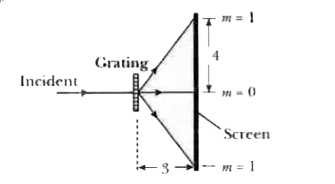
View Solution
PRACTICE QUESTIONS (Single Correct Choice Type) questions and complete solutions for chapter INTERFERENCE AND DIFFRACTION of RESNICK AND HALLIDAY PHYSICS (HINGLISH) of Class 12